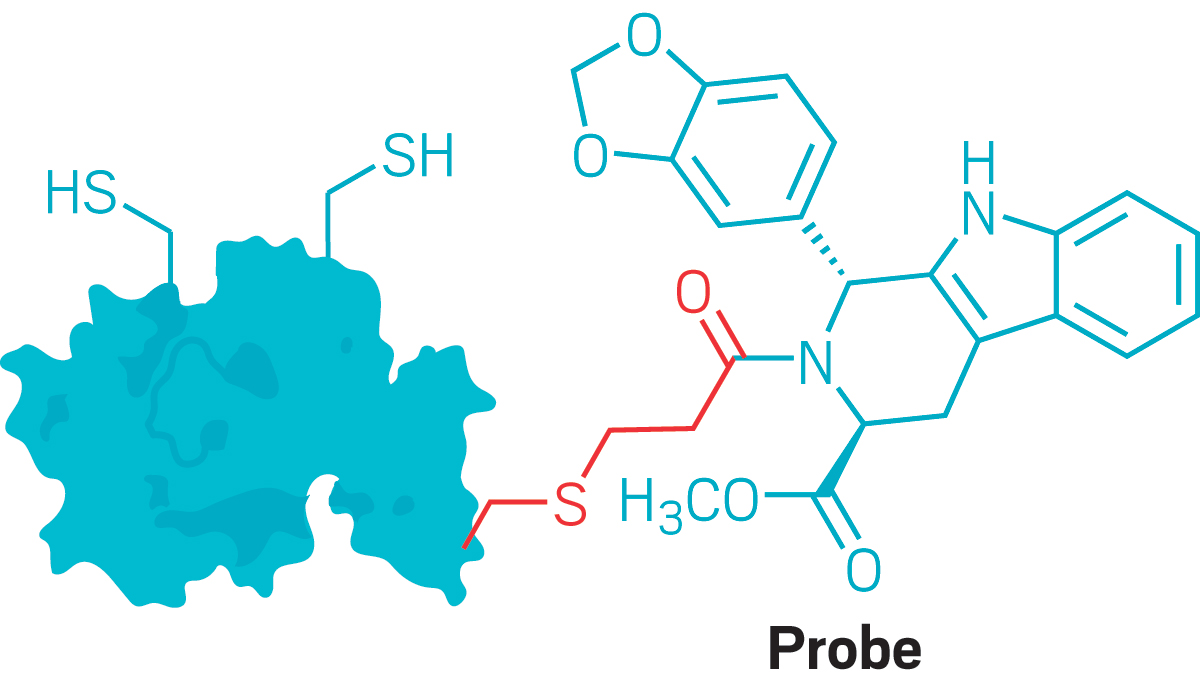Advertisement
Grab your lab coat. Let's get started
Welcome!
Welcome!
Create an account below to get 6 C&EN articles per month, receive newsletters and more - all free.
It seems this is your first time logging in online. Please enter the following information to continue.
As an ACS member you automatically get access to this site. All we need is few more details to create your reading experience.
Not you? Sign in with a different account.
Not you? Sign in with a different account.
ERROR 1
ERROR 1
ERROR 2
ERROR 2
ERROR 2
ERROR 2
ERROR 2
Password and Confirm password must match.
If you have an ACS member number, please enter it here so we can link this account to your membership. (optional)
ERROR 2
ACS values your privacy. By submitting your information, you are gaining access to C&EN and subscribing to our weekly newsletter. We use the information you provide to make your reading experience better, and we will never sell your data to third party members.
Biological Chemistry
Katya Vinogradova
Proteomics path paver is using organic chemistry to glean information on immune system proteins
by Bethany Halford
August 20, 2021
| A version of this story appeared in
Volume 99, Issue 30

Credit: Matthew Septimus/Rockefeller University (Vinogradova); Professor P.M. MOTTA & D. Palermo/Science Source (neuroglia cells); Shutterstock (centrifuge); Katya Vinogradova (mass spec trace)
Organic chemists do not typically reach for a half liter of warm human blood when they start an experiment. But Katya Vinogradova is not a typical chemist. She is using organic chemistry know-how to tackle big questions in biology. To do that, Vinogradova has taken an unusual path. She honed her organic chemistry skill set as a PhD student in Stephen L. Buchwald’s lab at the Massachusetts Institute of Technology. After doing some bioconjugation chemistry as a graduate student, Vinogradova was inspired to delve into chemical biology. For her postdoc, she decided to map the reactive cysteines in all the proteins in human T cells. This is where her story gets gory: to get those proteins, Vinogradova had to isolate T cells from 500 mL of human blood.
The sanguine science paid off. She and her colleagues found that more than 3,400 cysteines in roughly 2,200 T-cell proteins can be tagged by small-molecule electrophiles. Tacking small molecules onto these cysteines could suppress aberrant T cells that cause autoimmune disorders or could activate T cells to attack cancers. The cysteines could also serve as anchors for an emerging class of drugs called protein degraders, which tag misbehaving proteins for destruction.
Advertisement
“Katya is a rare talent with expertise that spans mechanistic organic chemistry, chemical proteomics, and human immunology,” says Vinogradova’s postdoc mentor, Benjamin F. Cravatt of Scripps Research in California. “Add into the mix her fearless approach to research and highly collaborative spirit, and you have an exceptional young scientist poised to make a major impact in her independent career.”
Vinogradova got an early start on her career in chemistry. Thanks to a nudge from her mother (who is not a scientist but loves chemistry), Vinogradova attended the Moscow Chemical Lyceum, a specialized chemistry high school in Russia. At just 14 years old, Vinogradova started doing hands-on research in glycoconjugate chemistry.
But Vinogradova says her passion for chemistry really emerged during her undergraduate studies at the Higher Chemical College of the Russian Academy of Sciences. That’s when she fell in love with organometallic chemistry. “I liked how you could use rational design to come up with novel methods to create bonds that you couldn’t before,” she says. As an undergraduate, Vinogradova spent summers doing research at labs around the world, including the University of California, Santa Barbara; the California Institute of Technology; MIT; the University of Burgundy; and the Swiss Federal Institute of Technology (ETH), Zurich.

In December 2020, Vinogradova opened her own lab, which is devoted to chemical proteomics and immunology, at Rockefeller University. She still uses small molecules to interrogate cysteines in proteins, but she’s hoping to map other amino acid residues too, including lysine and tyrosine. Because cysteine has been the main target for this type of mapping chemistry, using other residues to make these maps could open up new avenues in proteomics. Vinogradova also plans to study other types of cells, like macrophages, which are part of the immune system, and neuroglia, which are cells found in the brain and spinal cord. Her goal is to make discoveries that illuminate immunology and that might also lead to new therapies. “I like the basic side of science,” she says, “but I always like when there’s a path towards translational applications.”
Vitals
Current affiliation: Rockefeller University
Age: 33
PhD alma mater: Massachusetts Institute of Technology
Hometown: Moscow
If I were an element, I’d be: Sulfur. “It has been keeping me busy for many years (in the form of cysteine) and still manages to surprise me and lead me in new directions.”
Role model: “My mentors Steve Buchwald and Ben Cravatt for their passion for science, creativity, work ethics, and mentorship skills.”
Organic chemists do not typically reach for a half liter of warm human blood when they start an experiment. But Katya Vinogradova is not a typical chemist. She is using organic chemistry know-how to tackle big questions in biology. To do that, Vinogradova has taken an unusual path. She honed her organic chemistry skill set as a PhD student in Stephen L. Buchwald’s lab at the Massachusetts Institute of Technology. After doing some bioconjugation chemistry as a graduate student, Vinogradova was inspired to delve into chemical biology. For her postdoc, she decided to map the reactive cysteines in all the proteins in human T cells. This is where her story gets gory: to get those proteins, Vinogradova had to isolate T cells from 500 mL of human blood.
Vitals
▸ Current affiliation: Rockefeller University
▸ Age: 33
▸ PhD alma mater: Massachusetts Institute of Technology
▸ Hometown: Moscow
▸ If I were an element, I’d be: Sulfur. “It has been keeping me busy for many years (in the form of cysteine) and still manages to surprise me and lead me in new directions.”
▸ Role model: “My mentors Steve Buchwald and Ben Cravatt for their passion for science, creativity, work ethics, and mentorship skills.”
The sanguine science paid off. She and her colleagues found that more than 3,400 cysteines in roughly 2,200 T-cell proteins can be tagged by small-molecule electrophiles. Tacking small molecules onto these cysteines could suppress aberrant T cells that cause autoimmune disorders or could activate T cells to attack cancers. The cysteines could also serve as anchors for an emerging class of drugs called protein degraders, which tag misbehaving proteins for destruction.
“Katya is a rare talent with expertise that spans mechanistic organic chemistry, chemical proteomics, and human immunology,” says Vinogradova’s postdoc mentor, Benjamin F. Cravatt of Scripps Research in California. “Add into the mix her fearless approach to research and highly collaborative spirit, and you have an exceptional young scientist poised to make a major impact in her independent career.”
Vinogradova got an early start on her career in chemistry. Thanks to a nudge from her mother (who is not a scientist but loves chemistry), Vinogradova attended the Moscow Chemical Lyceum, a specialized chemistry high school in Russia. At just 14 years old, Vinogradova started doing hands-on research in glycoconjugate chemistry.

But Vinogradova says her passion for chemistry really emerged during her undergraduate studies at the Higher Chemical College of the Russian Academy of Sciences. That’s when she fell in love with organometallic chemistry. “I liked how you could use rational design to come up with novel methods to create bonds that you couldn’t before,” she says. As an undergraduate, Vinogradova spent summers doing research at labs around the world, including the University of California, Santa Barbara; the California Institute of Technology; MIT; the University of Burgundy; and the Swiss Federal Institute of Technology (ETH), Zurich.
In December 2020, Vinogradova opened her own lab, which is devoted to chemical proteomics and immunology, at Rockefeller University. She still uses small molecules to interrogate cysteines in proteins, but she’s hoping to map other amino acid residues too, including lysine and tyrosine. Because cysteine has been the main target for this type of mapping chemistry, using other residues to make these maps could open up new avenues in proteomics. Vinogradova also plans to study other types of cells, like macrophages, which are part of the immune system, and neuroglia, which are cells found in the brain and spinal cord. Her goal is to make discoveries that illuminate immunology and that might also lead to new therapies. “I like the basic side of science,” she says, “but I always like when there’s a path towards translational applications.”

















Join the conversation
Contact the reporter
Submit a Letter to the Editor for publication
Engage with us on Twitter